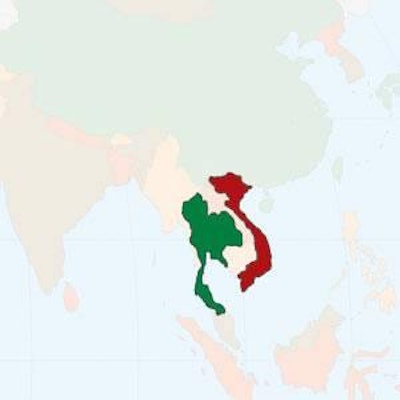
Thailand and Vietnam are two success stories in the ongoing siege of highly pathogenic avian influenza against Asian poultry industries. These Southeast Asian countries use different strategies but strive for the same H5N1 bird flu-free status, which they have tried to maintain since the end of 2005. So, the confirmed reappearance of H5N1 in Thailand during late July 2006 was the last thing anyone wanted to hear. But three years following the main assault, much more is known about the virus and disease which have killed more than 135 people since late 2003. Authorities reacted swiftly to the fresh Thai outbreak to gene sequence the virus particles, pin-point source of infection and take new control measures.
However, Thailand is surrounded by countries where H5N1 is almost certainly endemic. In Laos, Cambodia, and Myanmar the disease is masked by rural poverty and general disease, coupled with poor veterinary and medical facilities. Moreover, nearby Vietnam has the added problem of a northern border with China where the first H5N1 outbreaks occurred and where the disease has become endemic. The most likely scenario remains that benign H5N1 infection of waterfowl transferred to intensively reared chickens and subsequently exploded into a lethal epidemic disease. China is just two borders away from Thailand which is proving to be not far enough.
Thailand: Shoring up border breaches
Thailand's market-savvy poultry industry, led by Bangkok-based CP Foods, continues to promote exports of cooked poultry products into lucrative markets such as the European Union and Japan, although the country's quotas and zoonotic status are under constant review. Questions remain about the northern Thai boy's death in July, although infection was attributed to dead chickens he had helped to bury without wearing protection and the source of infection was subsequently traced to fighting cocks. Authorities claim infection was covered up by owners who knew the birds would be culled despite high market values often exceeding US$10,000 per fighting cock. At this writing, it appears that officials bowed to owner resistance and went away without culling the birds.
Compounding confusion in rural Thailand is the disappearance from the scene of former Prime Minister Thaksin Shinawatra, who was the victim of a non-violent military coup in September. He had been scathing in his criticism of poultry owners trying to hide the disease instead of immediately reporting the occurrence of sick and dead birds. Thailand's interim, military-backed government has shown no apparent change in H5N1 control policies. Once the July outbreak had been confirmed, Thai authorities had acted quickly, culling birds and imposing a 10 km restriction zone on the movement of all poultry within the affected area. Poultry imports had been banned, which suggests the infection may have been brought into Thailand via imported fighting cocks.
Areas affected by wet season flooding, which increases disease spread and persistence, were already under close scrutiny. At-risk provinces were identified as Kanchanburi in the west, Uttaradit, Phitsanulok, and Sukothai in the north, and Nakhon Phanom bordering Laos in the north east.
Soon afterward, Laos announced bird flu when 2500 chickens died at a farm in Xaythany district just south of the capital Vientiane. The H5N1 virus was confirmed by the Lao Foreign Ministry and a further 3500 chickens culled. The same farm was hit during the big 2004 outbreak raising questions about long-term persistence of the virus and whether the disease was eradicated in the first place. A single backyard duck 20 km south of Vientiane had been confirmed with H5N1 by Food and Agriculture Organisation workers in May this year.
The USA had granted Laos US$3.4 million in October 2005 to improve disease surveillance. The country is one of the poorest in the region and, along with Cambodia and Myanmar, is regarded as a weak link in the fight against H5N1. Veterinary services are basic at best and virtually non-existent in rural areas, making disease monitoring virtually impossible. Over 200,000 chickens have been lost to H5N1 in Laos since 2004, but unlike neighbouring Cambodia, Thailand, and Vietnam, there were no reported human cases. Some experts believe human cases and deaths occur but are missed within a general background of rural poverty and human disease.
Hard on the heels of the Lao outbreak was confirmation of a second outbreak in Thailand in Nakhon Phanom province on the border with Laos. Nearly 80 layer farms were hit by H5N1, some 300,000 birds were slaughtered, and the Thai agriculture ministry blamed contaminated egg trays brought over the border from Laos and re-used in Thailand.
Genetic sequencing of virus samples showed those from Phichit, closer to the border, were similar to the same virus circulating there in 2004 and 2005, suggesting reservoirs of infection in backyard poultry and fighting cocks. The gene sequences from Nakhon Phanom to the south are new to Thailand and closely related to H5N1 viruses currently circulating in southern China. Poultry smuggling across the region is clearly implicated.
Thailand is among the world's top poultry producers and the fourth largest exporter of poultry meat. A robust, export-oriented broiler industry run by some of the world's largest vertically integrated poultry companies was instrumental in allowing Thailand to get control of H5N1, but even this apparently is not enough.
Lessons re-learned are that illicit poultry activity, whether in Thailand's own backyard or across national borders, will continue to threaten its ‘model' commercial industry in the absence of biosecurity-based isolation. Moves towards isolation were already underway as 24 companies representing more than 1700 poultry farms agreed on a ‘compartmentalised' system of production. This includes a 1 km buffer zone around each commercial farm to exclude infection from poultry raised in backyards. Biosecurity experts at integrator Charoen Pokphand (CP Foods) have already introduced this system in 850 of the company's farms and believe it should be national policy.
Thailand's commercial poultry companies are unable to export raw chicken into major markets like Japan and the EU, but claim successful exclusion/buffer zone systems will eventually allow raw poultry meat exports to resume. Thailand's agriculture ministry had expressed hope before the September coup that the country would be ‘H5N1-free' within three years. At the time, some poultry exporters were not so sanguine and more may have that opinion now.
Not phased by the H5N1 outbreaks and confident of eradication, a team of trade negotiators planned to visit Europe in September. Their mission was to minimise the impact of planned changes to EU tariffs on Thailand's chicken and ask for an increased export quota in the expectation of implementation of a new EU quota system for cooked chicken, salted chicken, and turkey.
Vietnam faces down bird flu
Bordered by China and endemic H5N1 in the north, H5N1-infected Laos along the west and Cambodia at the south, Vietnam is under tight siege from the human-lethal bird flu. Vietnam was the worst-hit country in 2004-05 with 42 accumulated deaths, but subsequently suppressed the disease. No-holds barred culling and mass vaccination eliminated outbreaks in poultry and human infection, but H5N1 was stalking Indochina once again in August 2006. Confirmed outbreaks in Thailand and Laos followed by one at Prey Veng province in Cambodia right on the border with Vietnam, which put Hanoi on full alert and guard.
Vietnam has a long border with Laos and a shorter, though equally vulnerable, border with Cambodiaboth neighbours with weak veterinary services and probably endemic H5N1. Vietnam continued to claim no H5N1 outbreaks during 2006, but in late July several suspect situations near the Cambodian border gave cause for concern. These cases included the suspicious death of ducks in southern Tay Ninh province and a man in Kien Giang province in the Mekong Delta hospitalised with damaged lungs and, after eating duck meat, a high fever for seven days, which is the human incubation time for H5N1.
Subsequent reports from Ho Chi Minh City's Regional Veterinary Centre confirming H5 subtype in waterfowl in three Mekong Delta provinces (Tien Giang, Long An and Ben Tre) were ominous. H5N1 was finally confirmed in late August on a duck farm in Thach Phu district, Ben Tre province where the entire flock was culled. At this time of the year ducks roam freely in the Mekong Delta feeding on spilled grain from rice harvests with simultaneous increased risk of H5N1 dissemination.
China: Big imponderable
China remains the big imponderable in the H5N1 siege of Southeast Asia. Outbreaks in 1997, 2002 and 2003 were traced to mainland China and reliable information has been difficult to obtain ever since. In May 2006 OIE (World Animal Health Organisation) named China as one of the countries where H5N1 was under-reported. Recent confirmation that the first human death from H5N1 occurred in 2003 and not 2005 as claimed by China does nothing to bolster confidence.
Poultry smuggling across high mountains that separate China and Vietnam, estimated at 1000 birds per day into Lang Son province alone, is a big problem. Chickens are carried in bamboo cages to fetch US$2.20 per kilogram, three times the market value in China. Price differentials are exacerbated by poultry meat shortages in Vietnam, following culling of 50 million birds to stamp out H5N1.
Vietnamese officials intercepted H5 infected birds at Lang Son in April 2006 and found infected chickens and ducks on three border farms in the even more remote neighbouring province of Cao Bang with death of birds traced back to smuggled poultry. Nearly 250 km of peaks up to 1350 metres high, with extended families on either side of the border, make the region difficult to police but easy for H5N1 spread.
Nonetheless, Vietnam has been trying not to take any chances and has increased quarantine operations at border gates with China. Over 50 wild storks were slaughtered at a theme park in Ho Chi Minh City in early August after random checks showed birds carried the H5 component of the virus although appearing to be healthy.
Waterfowl are regarded as 'silent' carriers of H5N1 in Vietnam and present the biggest threat of new outbreaks. Vietnam's waterfowl breeding stock has doubled to 8 million since February 2006, said the Agriculture Ministry's Husbandry Department, despite a government ban on waterfowl hatching and breeding until February 2007. Total population of waterfowl in Vietnam is estimated at 50-70 million.
The autumn months of October and November are critical to the balance of H5N1 risk throughout continental Southeast Asia as wild waterfowl migrate southwards into Thailand and Vietnam and neighbouring countries. Recent history shows an H5N1 outbreak in Thailand is invariably followed by outbreaks elsewhere. Fortunately, the five member nations of ACMECS (Ayeyawady-Chao Phraya-Mekong River Basins)Myanmar, Laos, Thailand, Vietnam, and Cambodiaare planning to increase co-operation and training in the fight against bird flu. Plans must rely heavily on experience and expertise in Thailand and Vietnam, which are considered globally as second to none.





.jpg?auto=format%2Ccompress&fit=crop&h=167&q=70&w=250)











